Rotkohl (German Red Cabbage)
This post may contain affiliate links. See my disclosure policy.
A quintessential and popular German side dish, Rotkohl (braised German red cabbage) is the perfect accompaniment to your Sunday roast, beef rouladen, brats and more! This traditional Rotkohl recipe is the way my Mutti and Oma made it and is easy to prepare, can be made in advance, and can even be frozen!
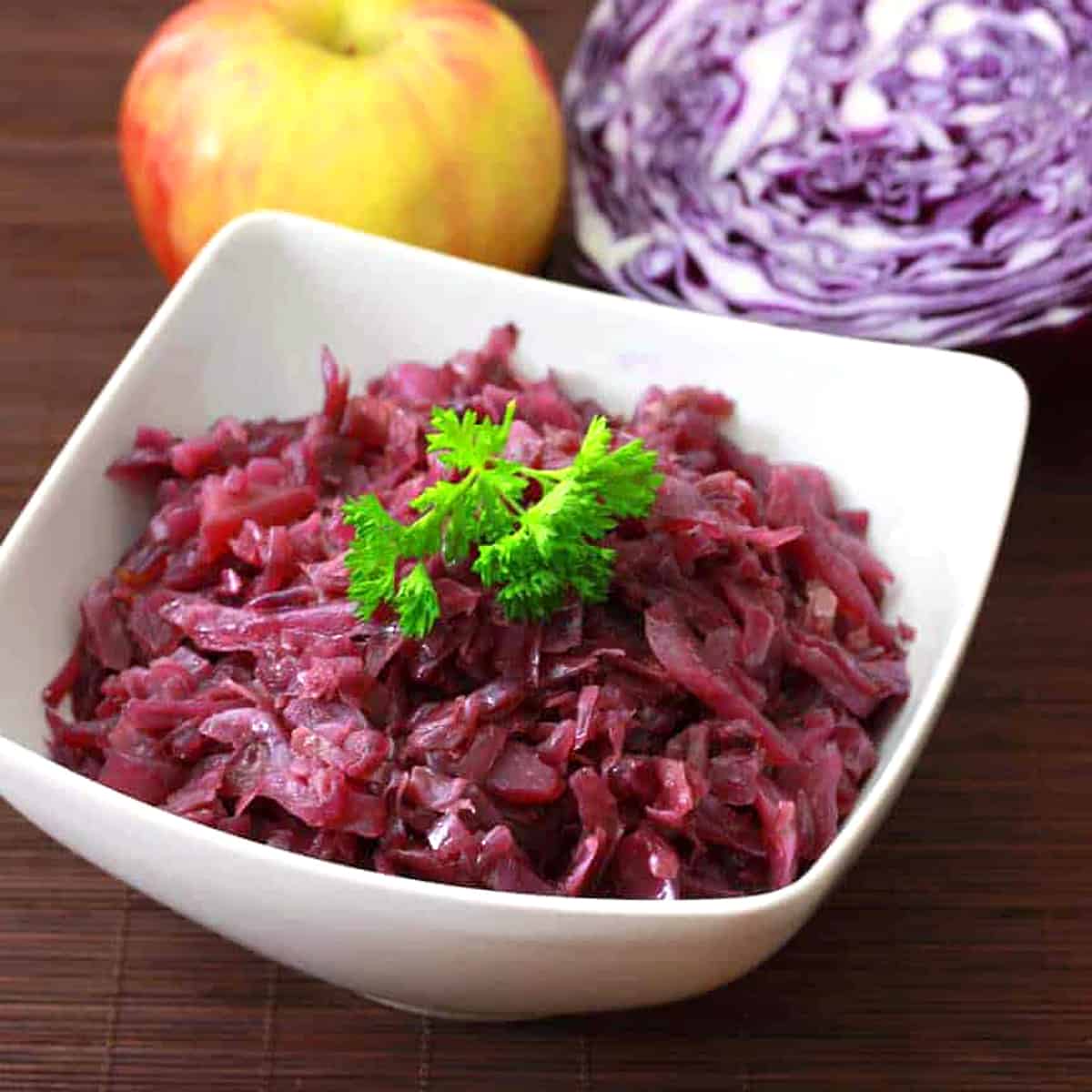
What is Rotkohl?
Known as Rotkohl, Blaukohl or Blaukraut in Germany, depending on the region, this braised red cabbage is a staple side dish that is served throughout Germany. It has a distinct sweet and sour flavor profile achieved by braising the red cabbage with apples, vinegar, and spices. A traditional accompaniment for beef dishes in particular, I grew up in Germany enjoying Rotkohl on a regular basis served with our Sunday roasts, Sauerbraten, and Rouladen.
This sweet and sour red cabbage has been around for, well, seemingly forever. And that’s how it usually works, doesn’t it? Great dishes stand the test of time. And Rotkohl takes the humble red cabbage and transforms it into something wonderful. If you’ve traveled to Germany or have sampled traditional German food, you’re likely familiar with Rotkohl. And this authentic German red cabbage recipe will transport you back to your favorite German dinner tables with memories of your favorite German meals.
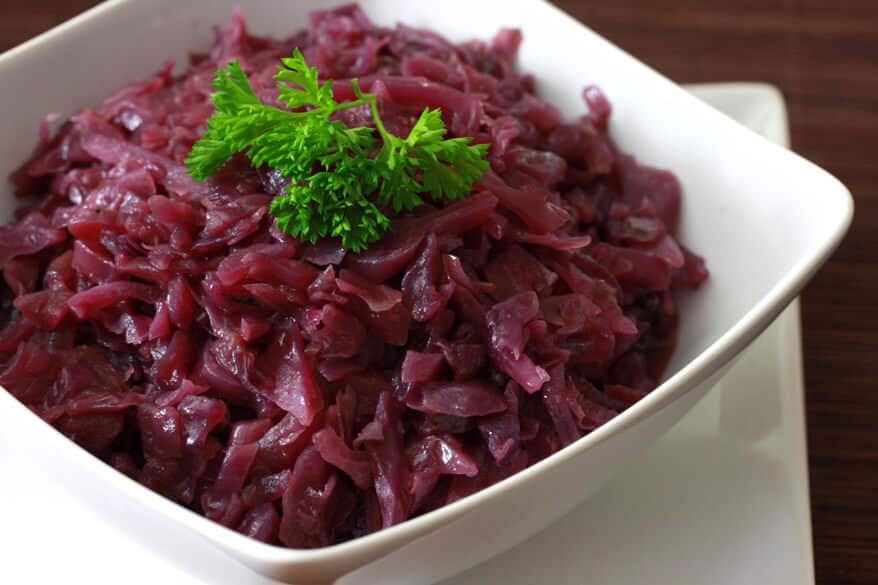
Rotkohl Ingredients
Butter, apples, vinegar, red currant jam, bay leaves, cloves and juniper berries are some of the ingredients that mingle together to create this delicious braised sweet and sour red cabbage. Just be sure to make time for the slow cooking process. It’s that long simmering process that’s key to the final outcome. The other key is to be sure to include all of the ingredients called for, including the spices, in order to achieve that authentic German Rotkohl flavor.
This traditional Rotkohl recipe is simple to prepare and can slowly cook with minimal attention while you’re preparing the other dishes or going about your daily business. It’s a great make-ahead dish because the flavor is even better the next day. Feel free to double or triple the batch because this sweet and sour cabbage also freezes well. Simply let it thaw and gently reheat it on the stovetop or in the microwave.
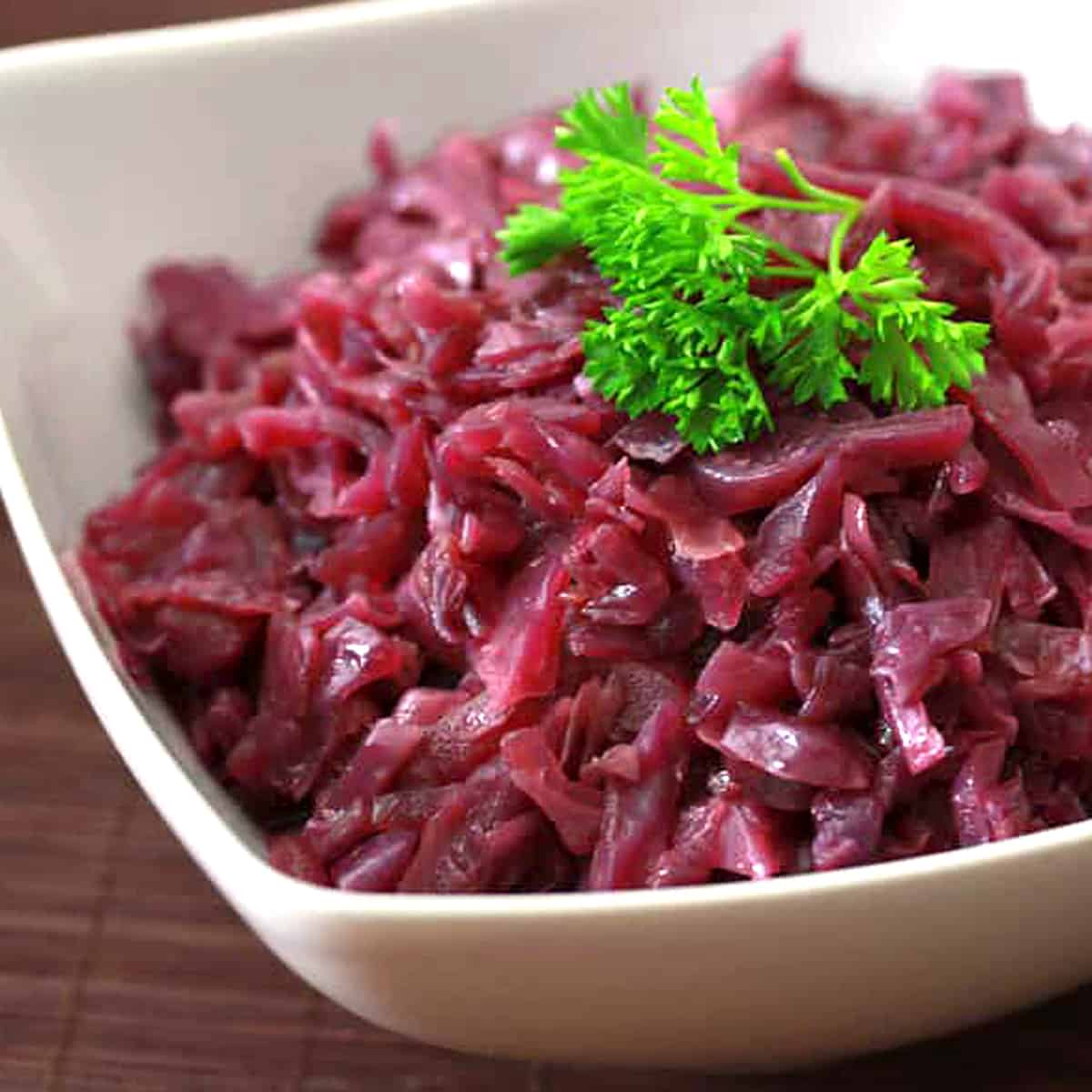
Rotkohl Recipe
Let’s get started!
Finely chop the red cabbage. Achieving exact uniformity isn’t necessary so you can do this either by hand or with a mandolin or food processor.
In a Dutch oven over medium-high heat, melt the butter and cook the onions until lightly caramelized, 7-10 minutes.
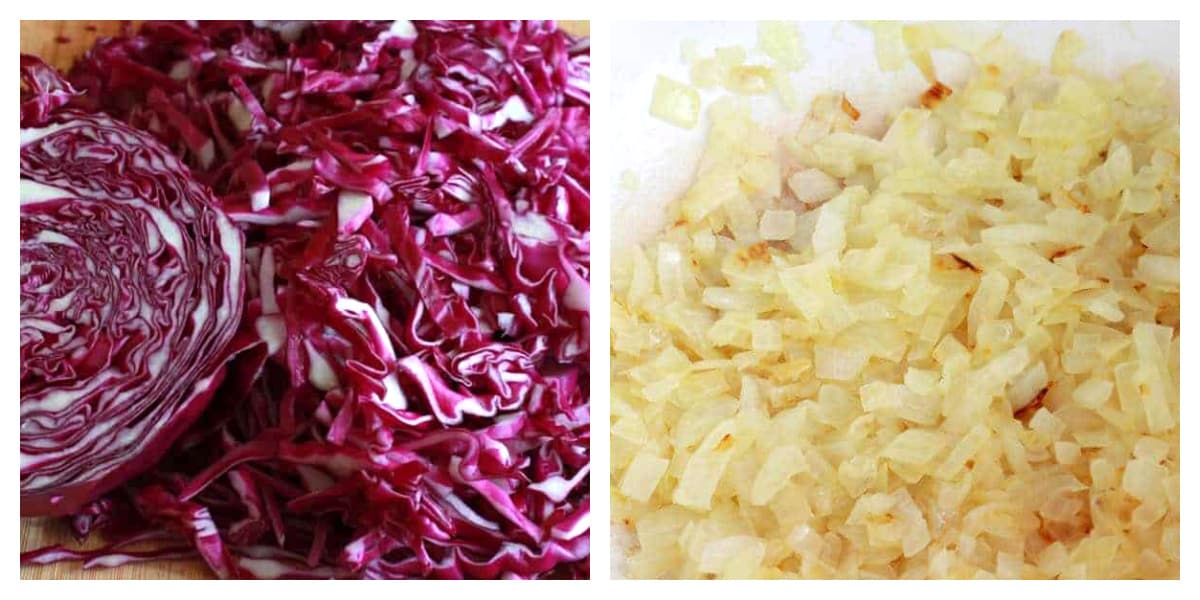
Add the red cabbage and cook for 5 minutes.
Add the diced apple along with the broth, bay leaf, whole cloves, juniper berries, red wine vinegar, sugar and salt. Bring to a boil, reduce the heat to low, cover and simmer for 2 hours, stirring occasionally. Add more broth if needed. Mix a tablespoon of flour with 2 tablespoons of water until dissolved and stir it into the cabbage. Add salt, sugar and vinegar to taste.
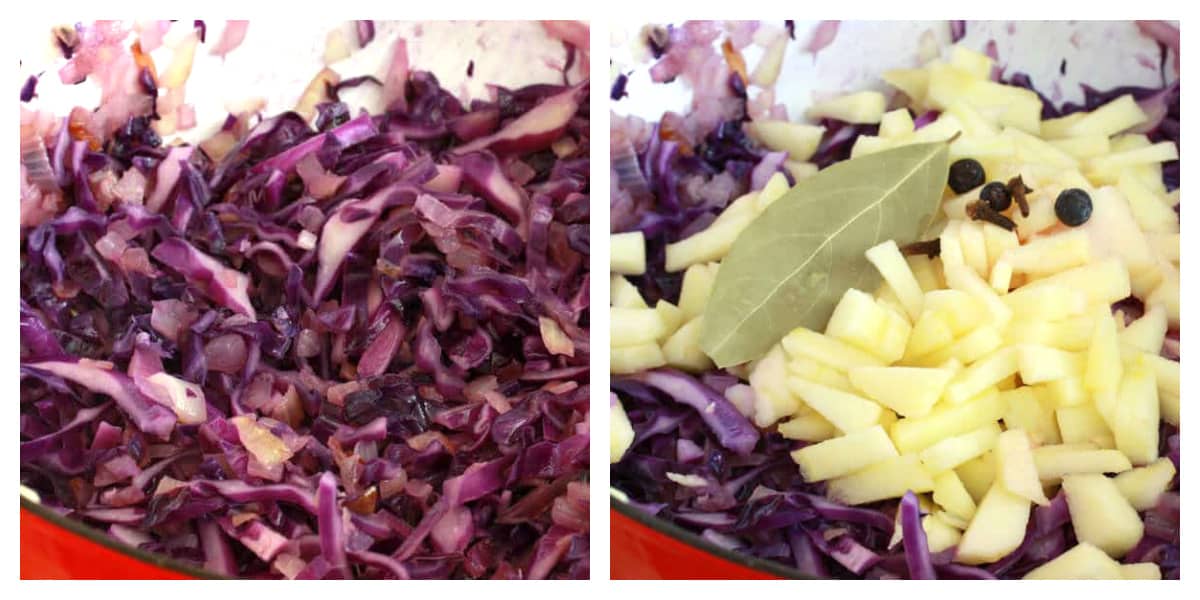
Enjoy!
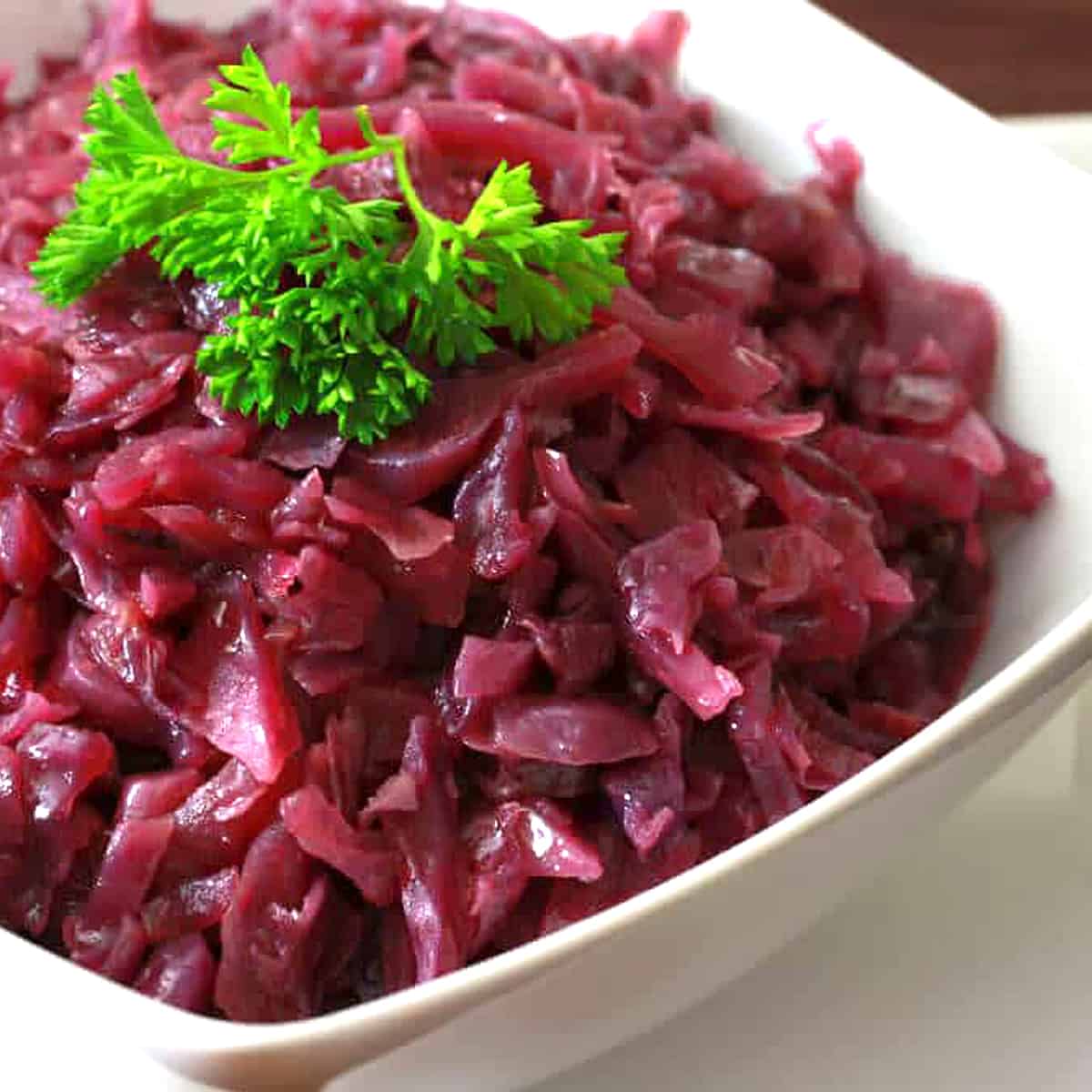
Serving Suggestions
In Germany, Rotkohl is the quintessential side to serve with roasts and a variety of meat dishes along with a carb of choice. Here are few dishes you’ll commonly see served with Rotkohl in Germany:
- Sauerbraten
- Rouladen
- German Goulash
- Schweinshaxe
- Spätzle
- Bread Dumplings (Semmelknödel)
- German Potato Dumplings (Kartoffelklöße)
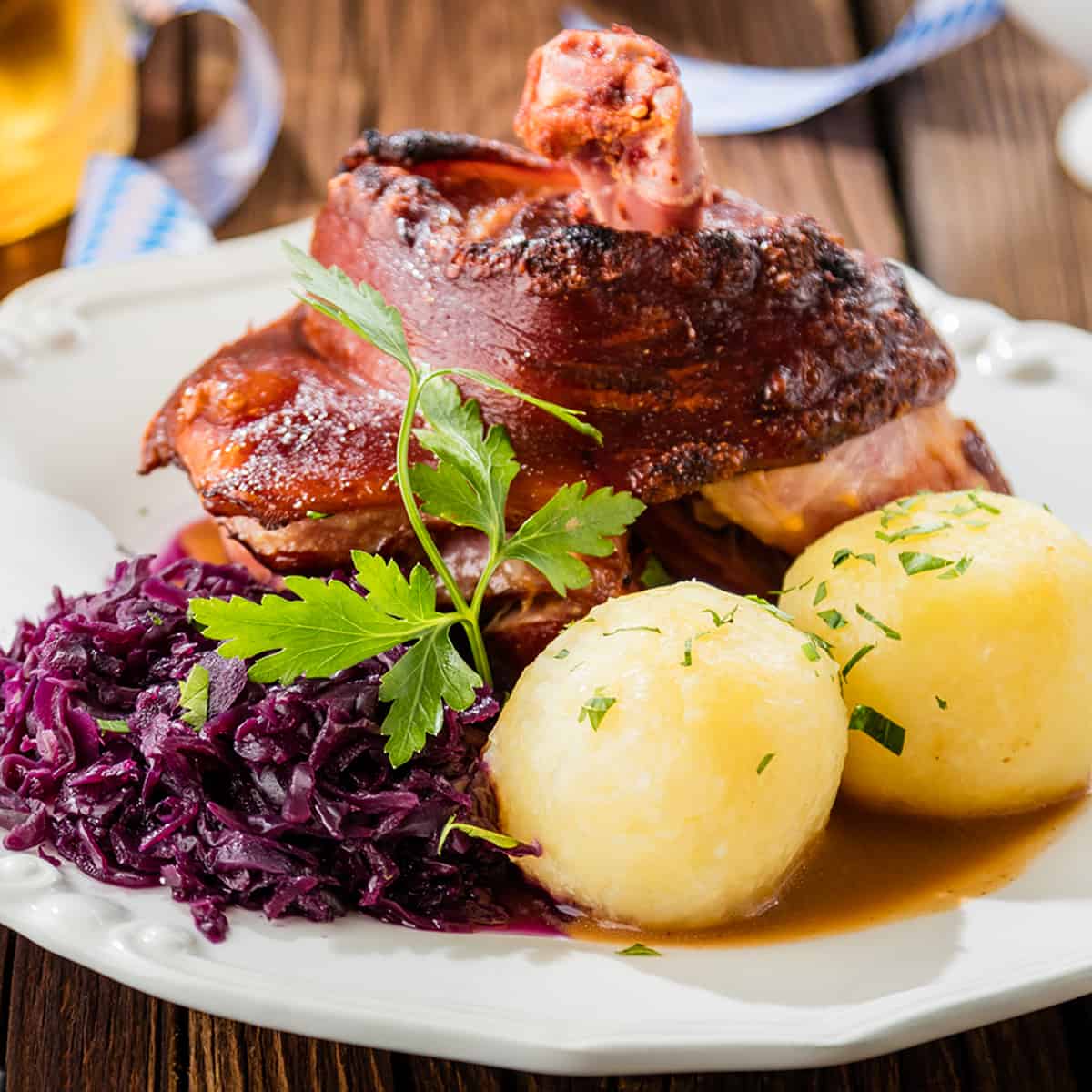
For more traditional German dishes be sure to try my:
- Spätzle
- Käsespätzle
- Rouladen
- Sauerbraten
- German Goulash
- Schweinshaxe
- Maultaschen
- Schnitzel
- Königsberger Klopse
- German Potato Dumplings (Kartoffelklöße)
- Bread Dumplings (Semmelknödel)
- Zwiebelkuchen
- German Bread (Vollkornbrot)
- Bratwurst
- Currywurst
- Swabian Potato Salad
Save This Recipe
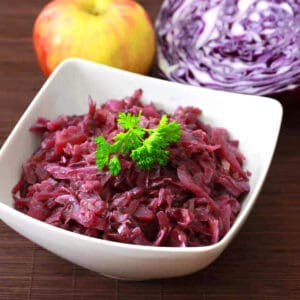
Rotkohl (German Red Cabbage)
Ingredients
- 1 1/2 pounds red cabbage , very thinly sliced
- 1 large yellow onion , finely diced
- 1 large Granny Smith or other semi-tart apple , peeled, cored and diced
- 1/4 cup butter (vegan: substitute oil)
- 2 tablespoons red currant jam or jelly , this is traditional but can substitute cherry jam
- 2-3 tablespoons red wine vinegar
- 1/2 cup vegetable broth
- 1 bay leaf
- 3 whole cloves
- 3 juniper berries
- 1 teaspoon sugar
- 1 teaspoon salt
- 1 tablespoons all-purpose flour (gluten free: omit)
- 2 tablespoons water
Instructions
- Melt the butter in a Dutch oven over medium-high heat and cook the onions until just beginning to brown, 7-10 minutes. Add the cabbage and cook for 5 minutes. Add the apple, broth, bay leaf, cloves, juniper berries, red currant jam, red wine vinegar, sugar and salt. Bring to a boil, reduce the heat to low, cover and simmer for 2 hours, stirring occasionally. Add more broth if needed. Combine the flour and water until dissolved and stir into the Rotkohl. Simmer for another minute. Add more salt, sugar and vinegar to taste.
- Traditionally served with roasts, Rouladen, and Sauerbraten along with potatoes, Spaetzle, German Potato Dumplings, or German Bread Dumplings.
Nutrition
Originally published on The Daring Gourmet July 23, 2014



















Can’t wait to try this. My grandmother used rendered goose fat but she said bacon grease will suffice. Since I lost her recipe this sounds very close. I will use bacon grease instead of butter though.
Wonderful, Joe, let us know what you think!
So tasty but WAAAAAY too sweet and I skipped the sugar in the recipe. I had to triple the vinegar and add a little lemon juice for the second hour of simmer.
Hi Isabel, I’m not sure what you were expecting this to taste like (it’s not sauerkraut which is very vinegar-heavy), but Rotkohl is sweet – specifically, it’s “sweet-sour”. Granted, whether something’s too sweet or salty varies from individual to individual, but there’s only one teaspoon of sugar in the entire batch, which you omitted. The couple of tablespoons of preserves, a traditional addition, adds flavor and an element of sweetness. I’m glad you enjoyed it otherwise and really, in the end, if tripling the vinegar is how you enjoy it best then that’s all that matters.
I need to make this for a crowd. Do you recommend doubling everything including the Juniper berries or even tripling? Thank you!
Hi Rose, yes you can increase the quantity by however many times you wish, just double or triple or quadruple all the ingredients accordingly. And this can be made at least a couple of days in advance as well and then reheated. In fact, the flavor will only get better. Happy cooking!
Are you able to can this recipe?
Hi Anna, I haven’t tried it but it would have to be pressure canned in any case (not water bath canned) and I’m not sure how that would impact the texture.
I am all set to go…but didn’t find red current jelly but found lingon berry jelly (I usually look for that for Swedish meatballs and cant find it…lol). I think I will use it in my red cabbage. Oh dear …. I forgot to get vegetable broth…but I have chicken broth…..(just wont be vegetarian).
Hi Bond, those substitutions should work just fine – happy eating! :)
Your recipe really sounds good, as i am eating my own homemade Rotkohl recipe passed down from my German mother. in her recipe chopped Bacon was used instead of butter. No flour or jam. used more bayleaf and whole cloves. and the apple isn’t put in until the last half hour of the 2 hour cooking. Sugar and white vinegar give it the sweet sour taste. But anyway you make it Rotkohl is the best. Always was made around the Christmas holidays and just the smell of it brings back those wonderful memories.
Thanks, Marie! It’s true for most German recipes that variations exist from region to region. They all add their little twists. But as with most any dish, it’s usually the one you knew from childhood that you find yourself going back to as an adult because, as you’ve pointed out, the memories associated with it are so meaningful.
Kimberly,I am so glad that you posted this recipe.I will make it this morning.Is there a brand of vegetable broth that you prefer? The ones I have tried have a strong onion flavor that I don’t like.Perhaps the long cooking time will transform that flavor into a more savory one in this recipe.
Hi Carol, I’ve used all kinds of brands and a strong onion flavor has never really stood out to me, but then I really love onions so that’s probably why. For this recipe I don’t think it will really matter which one you use because, like you’ve pointed out, the long cooking time is going to bring out all the other flavors. I don’t think you’ll notice the broth flavor. Happy cooking!
Sound great but could there possibly be any nutrients left after simmering for 2 hours?
Hi Linda, I suppose as many nutrients as would be left in anything slow and long-simmered (ie, stews). But the issue isn’t even so much the length of cooking time as it is cooking period (versus raw foods). From the NY Times: “Several studies have shown that while cooking can degrade some nutrients, it can enhance the availability of others.” Cooking enhances the digestibility of vegetables as well as the bioavailability of many nutrients.
I grew, and just harvested, red cabbage at my husbands request. ..he has never asked me to grow anything particular before. He spent 2 years in Europe, mostly in Germany, in the army in the early 70’s and absolutely loves this dish whenever we go to a local German restaurant. I will be surprising him for dinner tonight, with this…I’ll just be serving it with simple pork chops, but he will be JUST as happy!
That’s exciting, Samantha, and really neat that you’ve gone through all that effort for your husband. I’m really impressed that you grew your own cabbages. We were going to attempt that this year but never got around to it. You’ve inspired me to definitely give it a go next season :) You just can’t beat homegrown produce. I hope you both enjoy the Rotkohl. Guten Appetit!